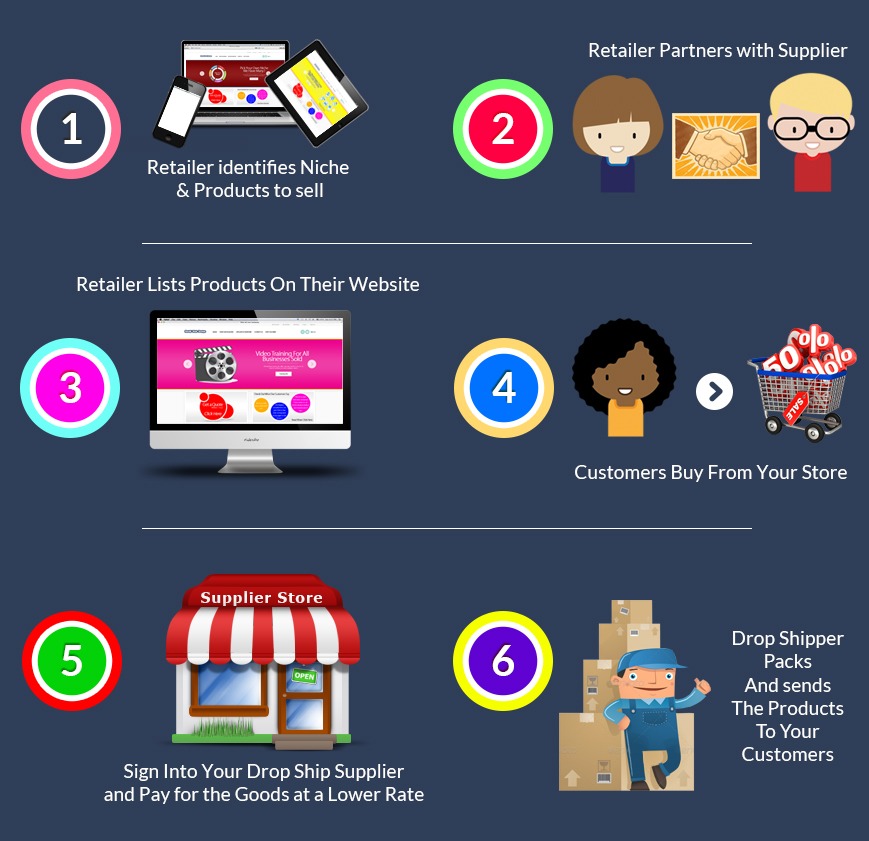eCommerce has changed consumers’ shopping habits. eCommerce has also changed the way companies and brands sell their products. Customer service and marketing are just as critical as ever. So what’s changed?
According to research by E-DSS.org, 22-33% of ecommerce merchants use dropshipping as their primary method of order fulfillment! Zappos began as a dropshipping company and both Amazon and Sears use dropshipping!
In today’s ecommerce world, fewer and fewer ecommerce merchants are actually coming into contact with the product, and not because they can’t, but because they don’t need to.
What is Dropshipping?
The concept of dropshipping is quite simple: the ecommerce merchant selling products from manufacturers does not do the shipping or come into contact with the product. Instead the ecommerce merchant partners up with another business that specializes in distribution to have this second party ship the products to the merchant’s customers.
Here’s a visual explanation from The Dropship Factory.
Advantages of Dropshipping?
Dropshipping is increasingly useful when the business is a one person show or if it’s a thriving business that has too few employees. Dropshipping does come with its own set of “costs”, however it also comes with a handful of advantages thanks to the fact that someone else is taking care of product development and order fulfillment. You’ve suddenly got more time!
One of the noted advantages include not needing to track your inventory or oversee a physical warehouse/storage area. All of the products are in the hands of the dropshipping service. A purchase is made on your site, and only then you purchase it from the dropshipper in order to get it sent to the customer. As a result, you’ve also got the advantage of not having to deal with leftover products at the end of the season.
The biggest advantage might be the savings – now that you don’t have to rent physical space or deal with products that don’t sell. You also have a low overhead, which simply means you have fewer expenses – a good thing when you are trying to grow into a successful business, and also more of a reason to start today!
To give you a bit more on the advantages, you can forget about needing to maintain a shipping and receiving (returns) system. That means you now have more time. What does more time on your hands mean for an ecommerce merchant? Having more time to research and add products to your site, more time to market on social media, creating a blog to promote the products, and much more.
Disadvantages of Dropshipping
One of the big disadvantages to using dropshipping for your business is that the profit margins are quite low. Quite simply, with dropshipping being so simple to get started with and available to a very large number of merchants, you can find yourself in a highly competitive dropshipping niche.
You could find yourself competing against many different merchants that have set their shop’s prices at a bare minimum, just ensuring that they’re making a minimal profit on each sale, and as a result, your profits are pennies.
Another disadvantage is the chance of finding yourself selling something that is out of stock. Yes, not having to deal and organize inventory is an advantage, but it also comes with a potential disadvantage. This disadvantage varies and is dependent on the quality of your dropshipping service as well as how many you are using – the more services you use, the more work you create for yourself. If you are a serious ecommerce merchant, you can probably minimize this issue by staying updated on the dropshippers website.
A third disadvantage can be shipping costs. This, like the previous disadvantage, is a potential one and its harm to you is dependent on the quality of the service you choose to work with. Shipping costs are already a pain, and with dropshipping the pain gets a bit bigger. Dropshipping services tend to get the products from dozens of different manufacturers, so before picking a service check how many different suppliers you’ll be purchasing from (fewer is better).
Are all of the manufacturers located in the same region? Do they themselves charge the same shipping costs? The answers to these questions can affect the shipping costs one way or another.
You could potentially find yourself having to deal with different shipping charges for the same customer if he/she ordered products from different suppliers. Do you place that cost on the customer? Your call, but remember that because profit margins are low, you’ll be facing an uphill battle if these get too high.
Finally, any type of service in the world can make mistakes. Dropshipping services too can make mistakes that’ll drive you nuts. No dropshipping service fulfills 100% of its orders 100% correctly.
Still debating whether or not this is for you? Check out this video.
Dropshipping Services
If you are going to use a dropshipping service, then your best bet is using the manufacturer of the products as the dropshipping outlet. This cuts your costs even more, and should also make the entire process smoother so you can put your mind to use thinking about improving conversion rates.
A simple rule of thumb is that as you limit the number of roadblocks, or in this case middlemen, the more efficient the entire process will be. When looking for the “ideal” dropshipping service, take these things into mind:
- What are their prices? Don’t just investigate the products you are interested in, rather take a look at all the prices so that you can get an idea of how they work. Remember, you get what you pay for.
- Are there handling charges, and how are they taken into account? If you can’t find any information about this, then make sure you contact the company – ask questions before you “get in bed” with them. Many companies just add this fee to the prices, but don’t assume that is the case.
- What is the shipping process like? Investigate if they use one company on a constant basis or if they use a different delivery service for different products/regions. We’re sure you have had different experiences with different carriers, so make sure you are giving your consumers the best experience. You may want to watch out for those that use small, local services instead of the popular FedEx/UPS, as it may be more difficult to get in touch in the case of a mistake in the order.
Here’s the big one…
- What is the service’s product return policy? You have got to delve into this topic, and ask fellow merchants what their experience has been in regards to this point with each dropshipping service you’re considering. The last thing you want is to be left in a situation where you have either no solution or you’re replacing the product at your own cost.
Popular Services
This is probably the most popular service for dropshipping, and for good reason: you can discover 2,055,360 different products to dropship. If you want to get started, all it takes is six easy steps to get into business: create an account (free trial), find a product, list it on your site, collect payment, process the sale with Doba, and then the product is sent to the customer.
With this service you can get access and choose what to sell from over 1,500,000 million products. All you have to do is create a free account, find products, activate a plan, and then start selling. Products will be delivered to your happy customers.
Similarly to the previously mentioned service, Dropship Direct is also super easy to get started with. This entails creating an account, find products, sell them on your store, once something is purchased from you then get it on Dropship Direct, and then the manufacturer ships the products to the customer.
Now you know what dropshipping is and how it works. Is this something you should try? That is a question for you and something you need to research. One great tip to help you make the decision is weighing the costs (not only physical money, but also time, and resources) versus the benefits. If the benefits outweigh the costs, then maybe dropshipping is for you! Good luck.
Make sure you reach out to us in the comment section if you have any questions about this topic or let us know if you have any tips from your own experiences in dropshipping.

Ty is a digital marketing enthusiast that can't get enough social media marketing and content marketing. He is the inbound marketing manager at StoreYa where he spends his days searching for the newest social marketing scoop and creating amazingly awesome content. If you’d like to chat with him, feel free to connect with him on any social platform.
Recommended articles
 Facebook Ads for eCommerce: 16 Strategies, Examples & Tips
Facebook Ads for eCommerce: 16 Strategies, Examples & Tips
 How to Build a Winning eCommerce Ads Strategy
How to Build a Winning eCommerce Ads Strategy
 Google Ads for eCommerce: Everything You Need to Know
Google Ads for eCommerce: Everything You Need to Know
 10X Your Traffic with PPC Management Software
10X Your Traffic with PPC Management Software
Comments
Powered by Facebook Comments





Thanks for the insightful article about dropshipping have just signed up on Shopify and praying i get good results,appreciated Ty